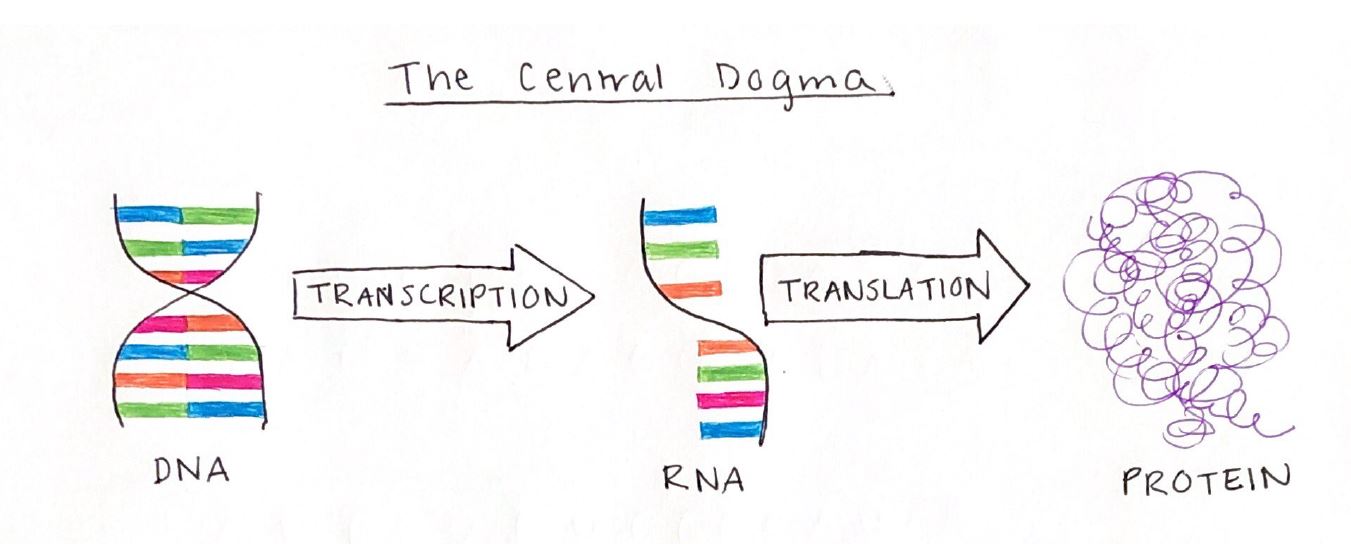If you remember any of high school Biology, you probably know that DNA contains the genetic code for all organisms on Earth. Within its double helix structure are genes, which provide instructions for characteristics such as hair color or eye color. What you probably might’ve missed in the 45 mins of lecture time that you instead spent drooling over the leftover Chinese food waiting for you in your lunch box (Okay, maybe that was just me), was that your genes actually encode for a functional product, usually a protein. These proteins make the pigments in your hair and eyes. It wasn’t until college Biology that I learned that the complexity of gene expression is beyond drawing Punnett squares.
Gene expression can also be simplified into the Central Dogma of Biology.. In a two-step process: (1) DNA gets transcribed into RNA, and (2) RNA gets translated into a protein. DNA-mRNA-Protein…sound familiar? However, gene expression is not just as simple as transcription and translation. Transcription and translation differ significantly in eukaryotic cells and prokaryotic cells. In eukaryotic cells, transcription takes place in the nucleus while translation occurs in the cytoplasm. In prokaryotes, however, both transcription and translation occur at the same time in the cytoplasm of the cell. The proteins that produce the pigments in our hair and eyes, for example, are synthesized by human or eukaryotic cells. Prokaryotes, like bacteria, have an entirely different mechanism of protein synthesis.

Bacteria in the Lab
Before I joined Dr. Pollock’s lab this summer, I worked a lot with E. coli bacteria in my freshman Biology lab. You’re probably thinking, E. coli?!?! That evil bacteria that stopped me from consuming my beloved Chipotle for a couple months back in 2015?!?! While there are certainly infectious strains out there, non-pathogenic strains of E. coli propel scientific research for a number of reasons. They are fast replicators, abundant, and can easily be grown under lab conditions. Additionally, they serve as an ideal host for foreign DNA sequences that contain instructions to make proteins. How exactly can bacteria synthesize foreign proteins? That is where the Central Dogma comes into play.
Transcription and Translation
DNA gets copied into a single RNA strand through the process known as transcription. The resulting RNA strand contains the same genetic code as the DNA strand, but simply in an RNA language. In bacteria, this transcription occurs in the cytosol of the cell. The RNA strand that is produced then travels to the ribosomes where it can then be translated into a functional protein.
During translation, the ribosome scans for a starting point, the “AUG” codon and begins translating the RNA into a sequence of amino acids to build the protein. There are a lot more cellular players essential for performing the transcription and translation steps – sort of like a baseball team that requires all the positions to be filled.
Our Research
So how exactly does bacterial protein synthesis work into our research on Team VLP? We work on a protein called Qb. This summer we have been transforming plasmids containing mutated Qb DNA into host E. Coli cells. These bacteria can easily exchange plasmids with their environment allowing them to incorporate our mutant DNA. The plasmid with the DNA contains the instructions for transcription and translation of the mutated Qb protein. The result is a functional, mutant Qb protein which we can purify from the E. Coli cells in order to perform characterization experiments. We are in the process of creating plasmids that contain new mutations to the Qb protein which will undergo the same processes as described above. Our ultimate goal is to understand the structure and function of these mutant Qb proteins and utilize them in a variety of applications. If you want to know more about these proteins and their applications, see the blogpost from my labmate Charlotte.
So the next time you think about why you have brown hair or blue eyes you could draw a Punnett Square or you could think about the DNA that encodes those genes, how they get transcribed into RNA, and translated into proteins that give your body the coloring that you have. And let’s not forget that our teeny tiny bacteria friends also have their own mechanism of synthesizing proteins. While the functionality of these proteins may not be visible to our own eyes, they contribute significantly to scientific innovation.
Cathy Bayas, 2022

Recent Comments